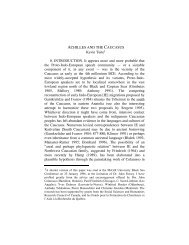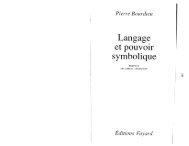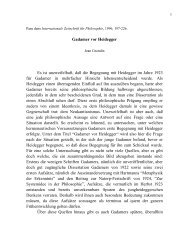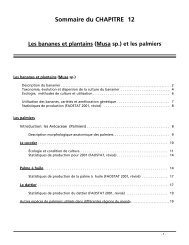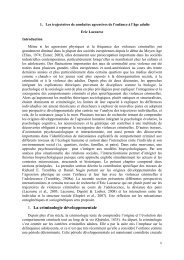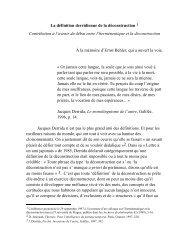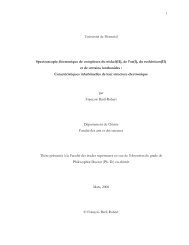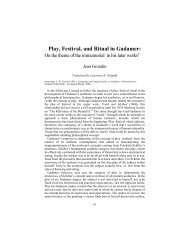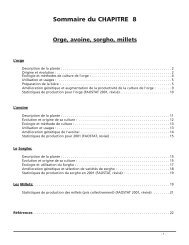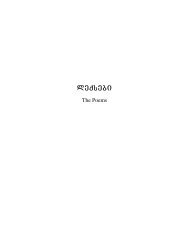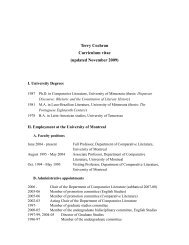Create successful ePaper yourself
Turn your PDF publications into a flip-book with our unique Google optimized e-Paper software.
ia mtazeda<br />
64. Eter, shen silamazita (“Eter, with your beauty”). Source: PKh 208. Recited by N. Khornauli in the<br />
Pshavian village Magraneti in 1939 .<br />
65. Aksha, aksha, mamalo (“Aksha, aksha, rooster, scram”). Source: PKh 208. Recited by N.<br />
Khornauli in Magraneti in 1939 .<br />
66. Zghvashi shatsurda k’urdgheli (“A rabbit swam into the sea”). Source: PKh 209. Recited by El.<br />
Elisbarashvili in the Pshavian village Shuapkho in 1946. Variants in OL 45 #65 and 63 #167.<br />
According to the Kartlian variants in OL (collected ca. 1880), the poet is spun around “like a<br />
whetstone” (kharat’ivita).<br />
67. Net’ain mamk’la mtashia (“May I die in the mountains”). Source: PKh 216. Recited by Ioseb<br />
Udzilauri in the Khevsur village Kvemo Kedi in 1946 .<br />
68. Tval k’i mich’erav shenzeda (“I have an eye on you”). Source: PKh 216. Recited by N.<br />
Elisbarashvili in the Pshavian village Shuapkho in 1940. Variants in LP 49, 174 .<br />
69. Nadobis k’abas vapere (“I likened it to my sister-spouse’s dress”). Source: PKh 206. Narrated by<br />
K’ok’o Udzilauri in 1938 in the Kakhetian village P’ank’isi. Variants in LP 129, 300. The central<br />
idea of the poem is conveyed by an omen, which Z. K’ik’nadze unravelled for me as follows: The<br />
shepherd is tending his flocks in the summer grazing lands. A butterfly appears, a messenger from<br />
the land of souls. The butterfly’s coloration reminds him of the dress worn by the woman with whom<br />
he had contracted a bond of ts’ats’loba, which can be read as an omen that she has died. The<br />
shepherd begs God that the omen not be true, and tells the butterfly to pass on some good news (his<br />
sheep are doing well) to his sister-spouse, wherever she is.<br />
70. Dghe tu ghame (“Day or night”). Source: Go 144-6. Variants in ShKh 143-144, 518-520; FY 139-<br />
140; SR 97-8 (in French). I will just touch on two details in the poem that require amplification:<br />
First, the straw upon which the young couple are enjoying themselves is probably inside a stable.<br />
The Caucasian mountain tribes used to have the practice, found in many parts of the world, of<br />
secluding women from the rest of the family during times of blood flow: childbirth and menstruation<br />
[ONS 140]. In some areas (for example Khevsureti) the women retreated to a special hut (samrelo);<br />
in Pshavi the stable fulfilled this role. Given the extremely grave consequences that an illegitimate<br />
child would bring crashing down on their heads, the young ts’ats’lebi usually confined their lovemaking<br />
to this time of the month, when the risk of pregnancy was at a minimum. The poem also<br />
contains a reference to a bottle of vodka, which the woman brings with her to the tryst in the stable.<br />
This calls to mind a ritual observed in Svaneti at the end of the last century: The couple forming a<br />
bond of lintural (the Svanetian equivalent of ts’ats’loba) seal their new relationship by invoking<br />
God’s blessing and drinking cups of vodka, as a sign that this bond was sanctioned by heaven as<br />
well as the community.<br />
140



